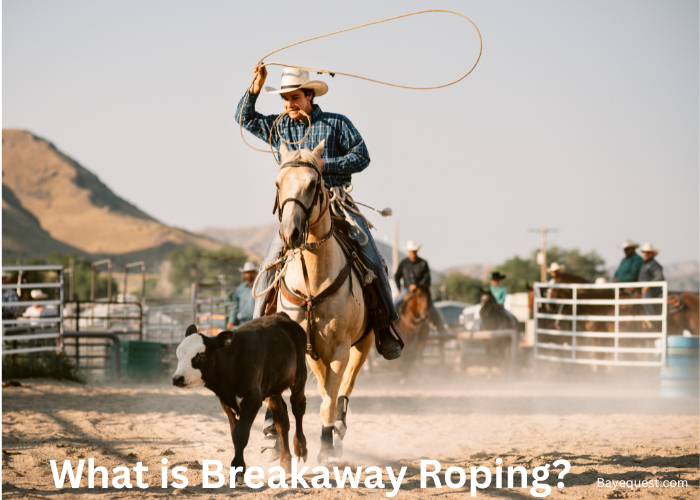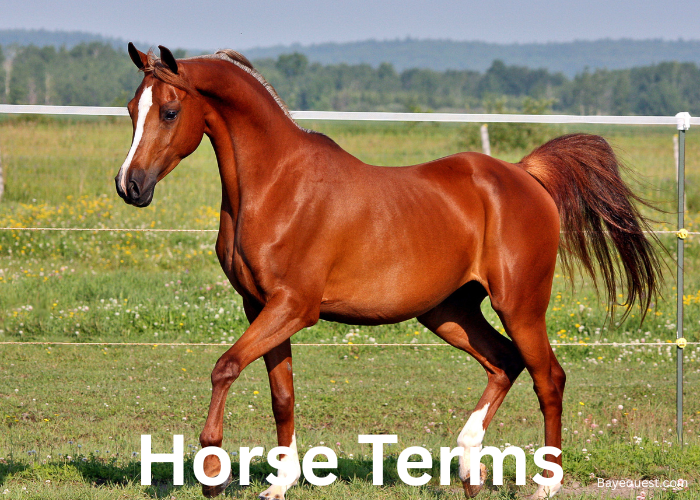Ever seen a cowboy chase a calf and stop it without even leaving the saddle? That’s breakaway roping. It’s fast, it’s intense, and it’s over in seconds.
Unlike traditional roping, the rider doesn’t wrestle the calf to the ground, just ropes it, and the rope snaps free.
It’s one of the fastest-growing events in rodeo, especially for women. Blink, and you might miss it.
But behind that flash is serious skill, perfect timing, and a strong connection between horse and rider.
Ready to see how it works? Let’s rope you in.
What is Breakaway Roping?
Breakaway roping is a rodeo event where a rider on horseback chases a calf and ropes it around the neck, but doesn’t throw it down.
Once the rope catches the calf, it’s tied to the saddle horn with a string. As the calf runs, the rope pulls tight and the string breaks, ending the run. It’s all about speed, accuracy, and clean technique.
There is no wrestling, no dragging, just a quick catch and release.
It’s one of the few timed rodeo events focused on precision and control, making it both exciting and crowd-friendly.
History of Breakaway Roping
Breakaway roping started on ranches in the American West. Cowboys and cowgirls needed a fast, safe way to rope young calves without hurting them.
Instead of tying the calf down, they roped it and let the rope break away. This method was quick and gentle, perfect for everyday ranch work.
This practical skill slowly moved into rodeo arenas. In the early 1900s, women began showing off their roping talent at small rodeos and exhibitions.
Back then, most rodeo events were for men. But breakaway roping gave women a chance to compete using skill, not strength.
By the 1970s, breakaway roping had become popular in high school and college rodeos. It allowed young cowgirls to enter the sport and develop their talent.
Over time, the event grew bigger. Today, it’s one of the fastest-growing events in rodeo.
It’s especially popular in the Women’s Professional Rodeo Association (WPRA) and is now featured in some PRCA events too.
Breakaway roping is more than a sport. It’s a mix of history, skill, and tradition, and it’s giving women a powerful voice in the world of rodeo.
How Does Breakaway Roping Work?
In breakaway roping, the rider starts in a box next to the calf chute. When the calf is released, the rider and horse chase after it at full speed.
A short rope, called a lasso, is swung overhead and thrown around the calf’s neck.
Once the rope tightens, it pulls off a small string that connects it to the saddle horn. This string “breaks away,” signaling the end of the run.
That’s where the name comes from, breakaway roping.
The rider doesn’t get off the horse, and the calf is never pulled to the ground. It’s all about speed and accuracy. The clock stops the moment the rope breaks free.
Penalties apply if the rider leaves the box too early or misses the calf. So, timing is everything.
Runs can be as fast as two seconds, making them one of the quickest events in rodeo. Although it looks simple, behind every clean run is a skilled rider, a trained horse, and hours of practice.
Why is Breakaway Roping Popular?
Breakaway roping is fast, exciting, and easy to follow. The action happens in just a few seconds, which keeps the crowd on the edge of their seats.
It’s a true test of timing, precision, and teamwork between horse and rider. It’s also one of the most accessible rodeo events for women.
While many traditional rodeo sports are strength-based, breakaway roping focuses more on skill and speed.
Fans love it because it’s clean and respectful to the animal. The calf isn’t wrestled or dragged, just roped and released.
That makes it popular with families and animal lovers, too.
Breakaway roping also gives young riders a great way to enter the rodeo world. It’s often one of the first events taught in youth and high school rodeos.
Gear Used in Breakaway Roping
Breakaway roping may look simple, but it relies on specific gear to get the job done fast and safely. Here’s what you’ll see in the arena:
Rope (Lasso). This is the main tool. It’s usually shorter and softer than the ropes used in other roping events, making it easier to throw quickly and accurately.
Breakaway honda. A special part of the rope that helps it snap away cleanly from the saddle horn when the calf is caught. This is key to ending the run and stopping the clock.
String or breakaway tie. A small piece of string or plastic connects the rope to the saddle horn. It breaks the moment the rope goes tight, signaling the end of the run.
Saddle. A lightweight roping saddle with a sturdy horn for tying the rope. It’s built for balance, speed, and security.
Horse. A trained, quick-footed horse is essential. The horse must respond fast and stop sharply the moment the calf is roped.
Rider gear. For safety and tradition, riders wear cowboy boots, a hat or helmet, long sleeves, and jeans.
What Kind of Horse is Good for Breakaway Roping?
In breakaway roping, the horse is as important as the rider. You need a horse that’s fast, smart, and calm under pressure.
The most popular breed for breakaway roping is the American Quarter Horse. These horses have explosive speed and quick stops.
They can launch out of the box fast and stop on a dime when the rope goes tight. That makes them perfect for timed events like this.
But it’s not just about speed. A good breakaway horse also needs to be focused, obedient, and responsive.
They have to stay calm in the box, chase the calf at full speed, and hit the brakes the moment the rider throws the rope.
Some riders train their horses for breakaway, while others start with horses trained for calf roping or barrel racing.
Size, temperament, and training all matter. The ideal horse is one that loves the chase, listens well, and works in sync with the rider.
When horse and rider are in perfect rhythm, that’s when magic happens in the arena.
What Are the Rules of Breakaway Roping?
Breakaway roping may be fast, but there are rules every rider must follow. Here’s how it works, step by step:
Start from the box. The rider and horse begin in a small area beside the calf chute. The horse must wait calmly until the calf is released.
Respect the barrier. A rope barrier is stretched in front of the horse. If the horse leaves too soon and breaks, 10 seconds are added to the final time.
Catch clean. The rope must go cleanly around the calf’s neck. If it catches the legs or horns or fails to loop properly, it doesn’t count.
Use a breakaway string. The rope is tied to the saddle horn with a thin string. When the calf hits the end of the rope, the string snaps off. That’s when the clock stops.
Stay in the saddle. Riders never dismount. It’s a catch-and-release event—no tying, no takedowns.
Fastest clean time wins. The winner is the rider with the shortest legal run. Most winning times are under 3 seconds.
Who Can Compete in Breakaway Roping?
Breakaway roping is open to anyone with the skill, speed, and heart to rope a calf. While it’s popular among women, depending on the event, both men and women can compete.
At youth rodeos, boys and girls often start learning the ropes together. It’s a common entry event for beginners because it teaches timing and control without needing to wrestle the calf.
Breakaway roping is a major event for female athletes in high school and college rodeos. It offers scholarships, titles, and a stepping stone to professional rodeo.
At the pro level, most breakaway events are for women, especially under organizations like the WPRA (Women’s Professional Rodeo Association). But some local and open rodeos welcome men, too.
What matters most isn’t age or gender, it’s control, focus, and hours of practice. With the right horse and plenty of dedication, anyone can chase the dream.
What Types of Ropes do Breakaway Ropers Use?
Breakaway ropers choose their ropes based on feel, speed, weight, and how well the rope “snaps” off the horn. Here are the main types:
Poly ropes
Made from polyester or a poly blend, these ropes are the most popular in breakaway roping. They’re lightweight, fast, and keep their shape well. Perfect for quick throws and clean releases.
Nylon ropes
Some ropers prefer 100% nylon ropes for a softer feel. They’re more flexible and forgiving, but may stretch a bit more. These are ideal for beginners who want more control during their swing.
Hybrid ropes
These ropes blend polyester and nylon to offer the best of both worlds: durability and smooth handling. Many experienced ropers use hybrids for consistency and feel.
Three-strand ropes
Lighter and quicker, these ropes are easier to handle and swing. They are great for ropers who rely on speed and finesse.
Four-strand ropes
Slightly heavier and more stable in the air. They offer better tip control, which helps with accuracy in high-pressure runs.
Breakaway Roping Vs Tie-Down Roping
Breakaway roping and tie-down roping may look similar at first glance, but they’re very different in how they’re performed and who competes.
In breakaway roping, the rider ropes the calf around the neck and stays on the horse. The rope is tied to the saddle horn with a string that breaks when the calf runs, stopping the clock.
There’s no dismount, no tying, just speed and precision. Tie-down roping, on the other hand, is more physical.
After roping the calf, the rider jumps off the horse, runs to the calf, flips it onto its side, and ties three legs together. The calf must stay tied for six seconds for the run to count.
Breakaway is less physically demanding and more animal-friendly since the calf isn’t wrestled or dragged. It’s a favorite among female rodeo athletes and is one of the fastest-growing women’s events.
Tie-down roping is dominated by men and requires more strength, endurance, and hands-on control. Both demand skill, but the style, rules, and energy are completely different.
Famous Breakaway Ropers
Breakaway roping has a growing list of stars who are changing the face of rodeo. Here are some of the most well-known names in the sport:
Jackie Crawford. Few names carry as much weight in rodeo as Jackie’s. With over 20 WPRA world titles, she’s a powerhouse in the arena and a major influence on the rise of women’s breakaway roping.
Shelby Boisjoli. Blazing fast and fiercely competitive, Shelby continues to dominate the pro circuit. Her lightning-quick loops and cool presence have earned her a spot among the sport’s elite.
JJ Hampton. When experience meets passion, you get JJ Hampton. With a long list of championships, she’s a rodeo icon and a mentor to young ropers everywhere.
Taylor Munsell. Coming out of college rodeo strong, Taylor brought her talent straight into the professional world. Her smooth, controlled roping style sets her apart in high-stakes competition.
Martha Angelone. Energy, speed, and precision, that’s Martha’s game. She’s quickly become a crowd favorite with her bold runs and fearless attitude in the box.
Conclusion
Breakaway roping is more than fast roping, it’s skill, timing, and heart. It started on ranches but now shines under bright arena lights.
With each run, riders show just how sharp and exciting this sport can be. It’s a crowd favorite for a reason: quick action, no rough handling, and pure precision.
Whether you’re new to rodeo or a longtime fan, breakaway roping is worth watching. It’s growing fast, and so are the stars behind it.
Check out what it means to break a horse for more rodeo insights and rider stories.







